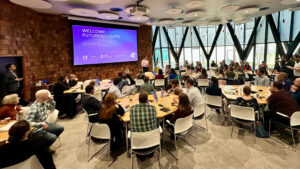

4th June 2019
Perils and Insurance Risks Facing Global Cities
Urban Foresight has presented early findings from its research for Lloyd’s of London, ‘The Maturing Metropolis’, at the annual conference of the Association of Insurance and Risk Managers in Industry and Commerce (Airmic).
Head of Infrastructure & Investment, Graham Thrower, was in Harrogate today to present Urban Foresight’s ongoing research, commissioned by Lloyd’s, on the global trends impacting on the insurance risks facing cities over the next ten years.
With more than half of the human population living in cities and other urban centres, this research will help inform the insurance market’s response to the changing and growing challenges facing cities around the world.
The research focuses on four key trends, namely:
- Urbanisation – from connected and sophisticated metropolises to unplanned and informal settlements, cities are on the rise. The global proportion of the population living in urban areas is increasing, as is the number of megacities of 10m+. Without a doubt, these large scale urban economies will be the powerhouses driving future global GDP.
- Population increase – the evolving makeup of metropolises requires innovative city development to meet the challenges brought by demographic changes including the need to dynamically manage housing, integrated transport and access to productive employment.
- The changing nature of work – cultural expectations and digital technologies are disrupting traditional ways of working. What will the impact be of artificial intelligence, automation and robotics, virtual and augmented reality, and the digital sharing economy in a municipal and global context?
- Political and social change – there is a macro trend of a shift in economic and political power to the East, signs of which are already at play. In addition to this, tensions are arising within countries, including between increasingly cosmopolitan, globally connected metropolises and their domestic hinterlands.
Key learnings from this work are the importance of understanding how these trends interrelate with one another. For the insurance industry, mapping these links discloses the nexus risks of water, energy and data and how these can lessen or heighten threats to the quality of urban living, human health, economic activity and city institutions.
“Market feedback from the presentation and the research welcomed the holistic view that we are taking and the way in which these nexus risks arise out of the interplay of individual trends” said Sam Nair, Project Manager of this research. “Urban Foresight are pleased to be providing these new perspectives to the insurance market to help companies and municipalities prepare for the rapid changes the world is facing”.
More Stories


Systems change and community building for a net zero future

Urban Foresight at the 2023 Smart City Expo World Congress

Urban Foresight to lead national net zero accelerator programme

Developing sustainable tourism in Cambodia


![cyberessentials_certification mark_colour [12] cyberessentials_certification mark_colour [12]](https://urbanforesight.org/wp-content/uploads/elementor/thumbs/cyberessentials_certification-mark_colour-12-pnvwipr8zh5rhqz25vzzioz2x8t2zltvu0gwqv4000.png)
